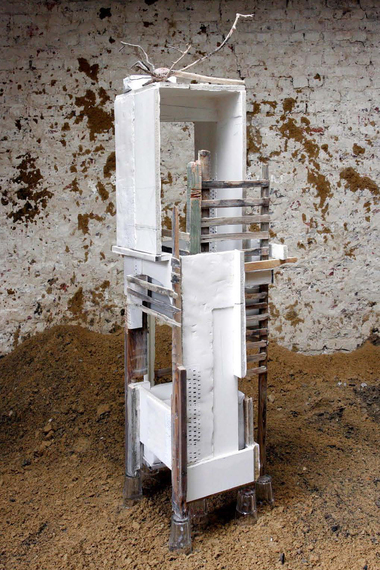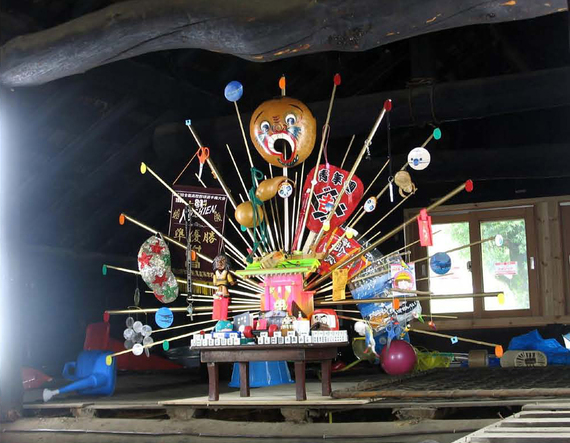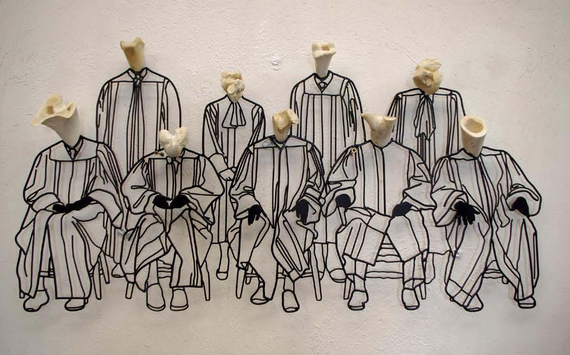In 2011, when I was writing for the now defunct Shanghai-based publication Public Art and Ecology, I wrote an article about the global trend toward repurposing materials in the fine arts. The article was accepted for publication but the magazine ran into undisclosed difficulties and was unable to publish their second issue. Since then, the universal trend to repurpose or salvage materials has grown and I thought it a good time to 'repurpose' the article for The Huffington Post giving these distinctive artists their proper place in the discussion.
Repurposing with a Passion
The process of repurposing materials has immeasurable benefits. There are instinctive, economic, esthetic, philosophical, and even political reasons to recycle, and visual artists are a very big part of this process. In an attempt to bring together compelling examples of this trend, I asked a number of artists from various parts of the world to answer four questions with the hopes of clarifying this ever-increasing phenomenon of repurposing with a passion.
The Questions
1. What sorts of materials do you recycle in your art, and where do you find them?
2. What specific incident or realization, if any, brought you to incorporate discarded materials in the making of your art?
3. What message do you hope to send to the viewers of your art in terms of esthetics and ecology?
4. Do you have a political or philosophical agenda?
The Replies
James Boman, who has his studio in Archway, England, makes art that is puzzling, His method of mixing metaphors in a non-linear narrative is somewhere between wild childhood fantasies and lucid dreams - even waking dreams, and they remind us that our world is filed with useful surprises that fuel the imagination.
Mr. Boman's responses: "Bike parts found in skips mostly, I'm a cyclist in London (Bethnal Green) and I absolutely hate it when I see abandoned bike parts left to rust. I have grown attached to my own bike and feel as though it has a lot of personality, it is alive to me and it saddens me to think that something that could be giving someone so much joy and excitement is just abandoned. I use a lot of objects from charity shops, I feel that these objects contain the most history and its fun to think of the journey that the object has taken to get to the charity shop and what the next stage in the objects history will be in my possession."
"When it comes to materials, I suppose money was always the issue, but that's not why I use found objects in my work - it goes a bit deeper than that. My passion is cycling, and I can't afford bicycle parts, I search through skips finding old bikes, build them up, replace parts - eventually I had amassed a great collection of parts, and I suppose, instead of throwing them out, I use them to make sculptures. I addition to bike parts, I collect all sorts of things - I suppose I enjoy making use of a discarded object and exploring the nature of it."
"I want to express character within my objects, and my hope is that people will simply enjoy the composition of these 'orphan' objects. I want my works to be fun, and thought provoking. I feel as though these objects all have a story to tell."
Ross Steven Caudill maintains a studio in Brooklyn, USA. His art is beautiful, absurd, challenging and thought provoking. His sculptures are about the subconscious - how it connects thoughts and memories - and how connections become both real and physical in his conscious mind.
Mr. Caudill's responses: "Lately, I have been working mostly with stainless steel which I purchase from a local metal yard. They acquire a majority of their metal from both the energy production and food industries. Then they will process and separate the alloys for recycling. I find it interesting to make artworks which provide philosophical nourishment from the very materials that make up the machinery which supports our physiology and civilization."
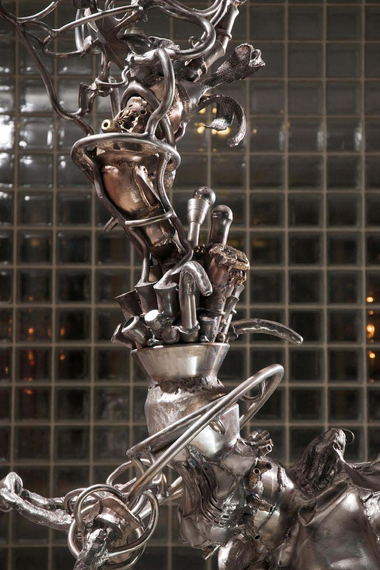
Ross Steven Caudill, The Great Resonator (detail) (2009), stainless steel, cast bronze, brass, 98" X 48" X 52" (courtesy of the artist)
"Moving to Providence, Rhode Island for my undergraduate schooling had a huge influence on my use of the "found object". Being in an urban setting formed from the industrial revolution allowed for the discovery of objects that had patinas and character shaped by manual labor. I was infatuated and nostalgic for these parts and inspired by connecting them in inventive and poetic ways."
"I believe art is an expression of beauty which is fundamentally derived from the observance of the natural world. If we can learn to appreciate with wonder the complexity of biology, we will gain a better understanding of how to relate to each other as humans. I feel an existential drive to build a dialog within my work that will address this goal."
"My philosophical agenda is to create works that may inspire some enlightenment or introspection in a viewer. I want to find links between the governing principals and forms of nature and how they relate to the human desire to understand purpose and consciousness."
From his studio in London, England, Wayne Chisnall creates art that references such things as structure, time and Modernism as they pass through a very contemporary mindset that focuses on humor, transience, functionality and futility. There is also the presence of popular culture in his thinking, as he addresses the differences between reality and perception, and how that affects the needs, wants and even the formation of the human psyche.
Mr. Chisnall's responses: "Although I have used plastic toys (which I collected from regular visits to car-boot sales, long before I knew what I was going to do with them) in one of my sculptures I am normally drawn to materials that I feel have a certain 'resonance'. These are usually organic materials that have either interacted in some way with the environment or with people. The materials vary according to the individual project but I generally use anything from wood, metal, glass, human hair, insects to bones and teeth."
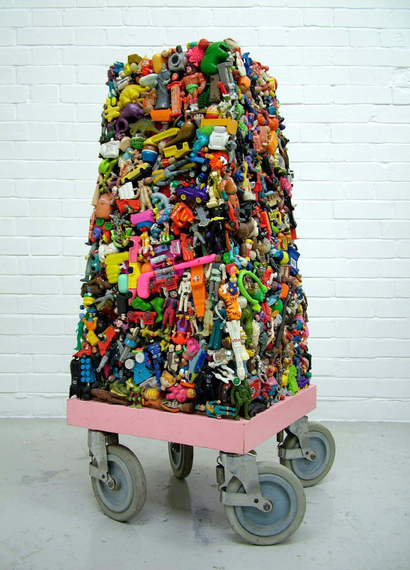
Wayne Chisnall, Magnet (1999), plastic toys, wood and casters, 44" X 18" X 18" (courtesy of the artist)
"As I prefer to use existing materials as opposed to freshly manufactured ones I tend to find my materials from all around me. This can become a slight problem however as I have a tendency to hoard more stuff than I will ever use."
"The rusty nails and screws that I used to complete my Nail Box sculpture where mostly just picked up off the ground and collected over a four year period. Although most of the nails were found here in London, a good portion of them were also collected whilst I was travelling round Wales, Scotland, Ireland, Europe, Thailand, Cambodia, India, Mexico and the US. A couple of them even came from inside the dome of Saint Paul's Cathedral, when I was working there on a project."
"One of the most abundant sources of materials for me over the last decade has been the skip where I work. I'm fortunate enough to work part-time at the Victoria and Albert Museum in London and with it being the biggest, if not the oldest, design museum in the world it produces an interesting array of waste materials (old and new)."
"The work of animators such as the Brothers Quay and Jan Švankmajer inspires me. As a child I grew up in awe of their dark animated short films and was hypnotized by the way in which they imbued tatty old bits of detritus with life. I don't know if this is where I gained my love of old things or if it just reaffirmed my passion for them, but either way, when I moved from 2D to 3D and started employing the use of found materials in my work, I felt that I was finally being true to myself as an artist."
"Through my art, I hope to show that there's a richness and beauty to be found in old and used objects that isn't evident in newly manufactured goods. By using materials that already show signs of their own personal histories I hope to build narratives where much of the story telling is already in place. Used objects tend to have an evident patina which we can all comprehend and by building with ready-loaded materials we can communicate with the viewer at an already engaged level."
Peter De Cupere has studios in Antwerp, Belgium and Paris, France. His primary intention is to produce scents using what, for ease of definition, I will call garbage. With this garbage, combined with other found materials, Mr. De Cupere creates wild and wicked combinations of textures, colors, shapes and juxtapositions that lure and assault every one of the five senses. With his art, he confronts the viewer with voluminous amounts of debris all in one place, posing some very difficult realities to inhale.
Mr. De Cupere's responses: "I recycle different sorts of materials in my art. Most of the time, the choice of the recycled materials is made based on the concept and context I am working on. I began working with recycled materials years ago as an art student, when I had little money to buy stuff. I depended on waste materials that people threw away. I found a beauty in it. First, it was the combination of recycled objects that gave meaning to the work. Later, it started to change when I combined found objects in with herbs, vegetables and fruits. This evolved into making works with recycled food exclusively. Like the work G-perfume I created in 1996-1997. A perfume made of the foods from my daily life. Over time, I kept the food that I didn't eat and let it ferment. Later on, I distilled it creating a perfume. I kept a list of all ingredients (9 pages) and presented this list with the perfume. The G stands for garbage with a double meaning."
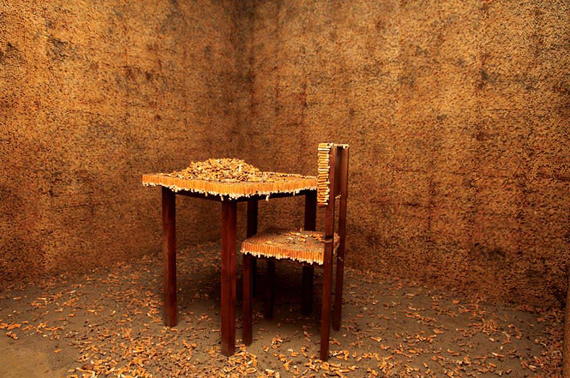
Peter De Cupere, Smoke Room (2010), olfactory installation: 750,000 cigaret butts, fragrances added: bacon-smoke and asphalt, 87" X 118" X 106" (courtesy of the artist)
"The most common things I find, cigarettes, where combined with smoked bacon to make a painting in 1999. In 2010 I made a room covered with more than 750,000 cigarette butts (not so pleasant smell). For this installation, I asked students to collect them for me, and for this, I paid their payments in the local pub. It took months to finish the work."
In her studio, and in the environs in and around Kent, England, Ruth Geldard turns her world into a place where fact and fiction can sometimes collide. Her art can be sensitive, and at other times pointed, but it is always testing our preconceived notions of strength and beauty, and the interconnectedness of our world in its many states of being.
Ms. Geldard's responses: "I employ dead stuffed animals, unwanted and abandoned things; things I can do things to that are "useless," lost with evidence of age and wear that I can glean or scavenge. I look everywhere: in second-hand shops, skips, bins, Ebay, on the street and in the countryside."

Ruth Geldard, ToCover 2, found log, remnants of kid glove leather, pink silk thread and glue, 25" X 9" X 7.5" (courtesy of the artist)
"My understanding of the emotional and relational nature of my interaction with certain objects (my collecting behavior) gave rise to research into the possibility of a gendered phenomenology. My work from that point on, has involved speculative experiments using objects materials and processes."
"My current work investigates and allows for a gendered response and awareness of subtle behavioral difference. The materials used are deliberately, aesthetically and phenomenologically seductive and oddly juxtaposed. The processes are constrained by complex and ambiguous verbs: To Nurture, To Smother, To cover, To Secrete, To Augment. Interaction with the work mirrors and magnifies behavior, sometimes provoking self-conscious recognition as part of a wider gendered identity. As the objects used are often from the natural world, this can induce a kind of nostalgic and almost reverent re-connection in the viewer's relationship to objects and materials."
"The possibility of a gendered phenomenological response to objects and materials, allows for the possibility of gendered behavior. For example: the public reception of Tracey Emin's My Bed 1998 exposed cultural and gendered anxiety, shame, and secrecy connected to issues of feminine hygiene. In retrospect, My Bed could be seen to function as a metaphor for women in the same way that Duchamp's Fountain became a metaphor for conceptual art. The feminine specificity of My Bed insinuates itself into the cannon of contemporary art. Cixous could be suggesting in the quote below, that women need to fully accept their female specificity in order to fully express themselves.
'Censor the body and you censor breath and speech at the same time. Write yourself. Your body must be heard.'
Current scientific research into gendered brain difference, allows for the possibility of a gendered phenomenology. Understanding how human's work could greatly inform ideas of and approaches to social ecology in the future."
Krzysztof Gliszczynski has his studio in Sopot, Poland. With his art, he pursues the flexibility of the past. He destroys as he creates, like a graffiti artist, but the difference is the intimacy, and his use of personal memory. He relives his past with forward thinking, and sees art as being an endless dialog that is never totally complete.
Mr. Gliszczynski's responses: "Initially, I started using the remains of my own artistic work - the "leftovers" after my creative process, scratched slivers, layers of a painting - the remains of painting substance, including pigment, wax, marble powder, vaporous substances. To be able to reuse that material, I put it into a water bath. Thanks to the ingredients I applied, the matter melted, so I could use it again. I added new features to that matter in the melting process thanks to additions, which were substances related to existence such as ash and soot. Recently, I have started using other materials like disposable gloves which I use while working, tins-vessels in which I melt the used material in water bath."
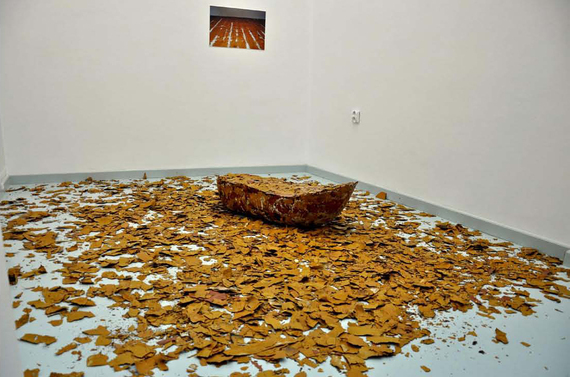
Krzysztof Gliszczynski, Impressed Memory Object (2010), paint scratched off the floor of family household and paraffin, 18" X 47" X 118" (courtesy of the artist)
"In 1992, while I worked on my work Dialogue with the Absent One in Worpswede, I removed the final layer of my painting to reveal the drawing underneath. The matter spilled onto the floor and that made me reflect. Valuable material, prepared especially for that painting suddenly became some unnecessary trash, fated to non-existence. That reminded me of the work of a room decorator who removes the old layer of paint from the walls. Since that time on, I have been collecting the remains of my working."
"This practice is for me, is a dialogue I have with Ad Reinhardt's statement: "I am aware of the fact that I am painting one of my last pictures." An urn has some characteristics of painting itself, as, naturally, it stems from it, and, at the same time, it proves to be its classical opposition. An urn is precious enough to store remnants left after the process of painting. Or, it is precious enough to be buried with due honors. An urn is grief itself, a strong relation of loss and the desire to regain what has been lost. An elegiac feeling of loss, a feeling that nothing would ever be the same - becomes an inspiration for me. Destruction itself brings a need for order and organization. This is why my "urns" are given numbers and dates (usually relating to the timeframe of the work)."
"What is most important is the philosophical message, which touches upon the material and the spiritual. There is a certain dichotomy that appears between matter itself and the significance it carries - or that which we give to it. A rejected thing, considered unnecessary, has some value within itself that we can notice upon reusing it. The context of the memory comes in between the personal and the social, so do the empty vs. the full and the internal vs. the external."
From his studio in Ghent, Belgium, Olivier Goethals produces haunting sculptures that reference urban decay. He is an architect and a teacher, yet his sculptures bring the uneasiness of absurd combinations and juxtapositions. Most importantly, he brings us a world of personalized intimate decay that has a tinge of joyous discovery.
Mr. Goethals' responses: "I use recycled materials I often find and collect on building sites: cement, plaster, wood, brick, paint, sand, concrete, paper... mixed with other idyll minutiae that lost its usefulness, but still has a history or story to tell. For example, I have used milk glass in my sculptures that was once owned by my grandmother, something I know I used when I was a child.
"I am very interested in the esthetics of non-design, of coincidence, as well as the esthetics of the normal. Discarded materials have a history; they have different layers; they had a life and a different meaning before I re-incorporated or re-use them for a sculpture or installation. This resulting multilayered texture is an interesting starting point to work with; it is free for anyone to use.
"I have no specific message that deals with ecology as such. It is more about sustainable thinking and behavior of people. I dislike the culture that everything should be new; spotless and traceless. I believe that history/time and usage can enrich objects/places/architecture. Being young is not an achievement; not for people; not for things. we should allow things to alter, change and deal with what results as an enriching patina, and not as a reason to consume for the goal of the new and fresh that is often find boring. Venice is only beautiful because of the imperfection of its architecture; its visible multilayered history in a contemporary, and tourist-centric setting."
Catherine Johnston maintains a studio in Victoria, Australia. The art she creates is curious, mysterious - the thoughts she inspires settle somewhere in our minds as a semi-conscious thought. The line between reality and fantasy is not necessarily blurred, it's banished. Her art makes us think of the possibilities, whether they are practical, dangerous, fluid or factual.
Ms. Johnston's responses: "I recycle most materials within my sculptures. Discarded leather furniture becomes pattern pieces in new works; these are found by the side of the road or donated by friends and family. Broken watches and watch batteries get encased in cast resin shapes and breathe new life; these have been accumulated over the years in my 'past life' repairing watches in the UK while starting out on my sculpture path, and also from approaching jewelers who happily clean out their scrap piles for me. Op shops (opportunity shops) are also a great source of reclaimed objects constantly used in my sculptures.
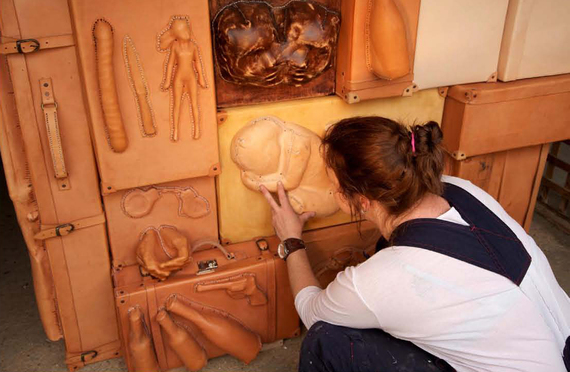
Catherine Johnston, Monkey (2011), molded leather objects on leather suitcases, on wooden frame, 67" X 90.5" X 71" (courtesy of the artist)
"As an art student... 'who can afford to buy materials?!'. Factory recycle bins, theatre props bins, found objects and more formed the core elements of my works. And now, as a full time practicing artist I am still a creature of habit and necessity. Using old objects in new works lend the work strength of concept and depth of life that a new object cannot possibly achieve. They create new possibilities and by familiarity of a common social history, create stronger connections with the viewing public."
"My works deal with quite powerful messages and thoughts. The strength of these messages can often be quite confronting to the everyday viewing public. I find by being true to the traditional sculpture methods of making a beautifully crafted work, and making it to excite and connect with people, I am able to draw people in to engage with my work. And once they are 'there' they are open to absorbing the subtle and not so subtle messages my work hopes to generate thought and response about. Though I can appreciate the concept and bravery of the ephemeral in other artists work, in my practice I am not interested in the 'throw away' nature of current western society - my sculptures are made to last. The photography and installation work I do often comments on mass production and consumerism gone wrong, and the resulting depersonalization of humanity. In the darkest of places beauty can still be found. I believe by showing this beauty you allow people to go into the darkest of places, and through that journey they are changed.
"In my residencies lately I have been working with disadvantaged youth and victims of domestic violence. By giving thought a voice, giving a form to the formless, I see these people blossom in their self-belief and awareness of their power to make a difference in their world. I see their pride and hope fire up... and I know that I am making a difference."
"And so... with a smile on my face and empty pockets... I keep scrounging bins and scraping the accumulated muck off a falsely constructed reality... like a creative little pig in mud."
Ismet Jonuzi's art, like his life, carries the scars of a bloody war. His art is direct and symbolic, and his desire to tell his story, the story of his homeland and his people is his passion. He maintains a studio in Prishtina, Kosovo.
Mr. Jonuzi's responses: "I use the very same weapons from the war in Kosovo to make my sculptures. I discovered them in factory where they were collected to be destroyed. These weapons have been made useless, and in a way, I have given them new life. What better way to openly demonstrate the war is over."

Ismet Jonuzi, Black Hawk (2003), found weapons from the War, 47" X 23.5" X 71" (courtesy of the artist)
"I was always fascinated by the Nouveau-Realists such as César Baldaccini and Jean Tinguely, as I always try to do something strange and unknown. For a long time I have collected different found objects and materials to make my sculptures, such as car parts or everyday objects from life. But weapons, for me, are the most powerful material. They are the only objects which speak concretely about the war and the violence."
"With these weapons I can explain the reality of war in my Country. These are the actual weapons people fought with. Machine-guns, Kalashnikovs and knives that are made to take lives and destroy them . Through the shape, line and volume I have tried to express the drama that we have experienced as a community in this part of the Balkans. My work represents the wounded soul of my homeland."
"From the very first moment, when I saw the weapons, I immediately felt strange and afraid. Weapons are fear, war, power and death. For a long time I had them in my studio before I could do anything. I would think to myself, what should I do with all of them. That is when I started to make my sculptures. An even though they are sculptures to the viewer, they still remain weapons to me."
Masaki Kishimoto has his studio in Tokyo, Japan. His art is steeped in the culture of the popular, tourist memento. The resulting assemblages he creates are explosions of color and form that are mesmerizingly and insanely beautiful, and remind us of the gaps between the harshness of reality, and the promises of fantasy.
Mr. Kishimoto's responses: "I am especially inspired by an acquaintance's souvenir - the important ones that are not thrown away, but somehow not needed. I gather them not as garbage, but I intervene just before they are lost, tossed aside or broken."
"My concepts or thoughts do not necessarily find there way to the viewer's thought process. The message often stays with me, the sender. What does translate well is the strength of the material designs and the vagueness that my work produces when seen is such accumulative forms."
"My art is a comment on the fragility of the materials, as much as it is about the event or reason it was created for mass consumption. To some, these objects are meaningless or unimportant. To me, they speak of many things."
Ana Krstić, who studied art and philosophy in Belgrade, Serbia, maintains her studio in Mionica. She creates works that make the viewer more aware of their wasteful consumption. Her sculptures, performances and installations also address stereotypes or preconceived notions about wealth, gender, even ambition leading us back to the actual natural beauty that still surrounds us.
Ms. Krstić's responses: "In my installations, I use mostly plastic, nylon and rubber - and later on, I combine it with video works. Sometimes I use material that was discarded, like plastic bottles, but more recently, I simply go and buy the material, usually in stores that sell plastic for domestic use, or in Chinese shopping malls. I don't feel happy about buying instead of using already used material, but I need my objects to be as shiny and as new as possible, because it is exactly the effect that these shiny objects have on us, that I try to use as an element in my work."
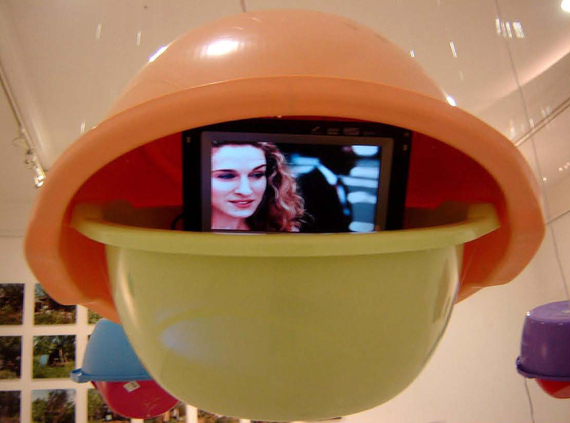
Ana Krstić, The City Girls (detail) (2010), mixed media installation at Nadežda Petrović Memorial, Čačak, Serbia, 138" X 197" X 236" (courtesy of the artist)
"To me, discarded materials are just like stone, wood and clay were to our ancestors. It is around, it is part of our lives, it is within our reach, and it is not to be ignored. During my classical sculpture studies, young people are required to accept that stone, wood and terracotta, for example, are precious materials. I agree on that point. However, taking an already beautiful peace of stone from nature to carve something in it - and I don't care how beautiful the final work is - it is, in a way, a blasphemy. There is nothing as beautiful as a rock, standing in nature, carved by nature, left there in peace. The work of Hamish Fulton made me realize that."
"I feel bad every time I go and bye new plastic for my work, I honestly do ( although I reuse them, and I don't throw them away). I talked about it with a friend and she said - "well it is going to be used anyway, for much less useful purpose than art, at least you are sending a message." So after this I thought to myself, I am sticking with plastic ... I can't see any other way of making people aware of how bad plastic is for them than using it in my work, putting it in a gallery, trying to break the magic of "pretty, pretty - shiny, shiny".
"We are living in a world of delusions. We have made a make-believe luxuriance for the minority, and everybody will pay for that - all while nature is turning on us. I try to break some of the delusions that affect my life, that I am aware of, and in that sense, my work speaks from primarily a female and feminist point of view."
Fiona Long is based in London, England. She's completed a residency at the Chinese Arts Centre in Manchester, and has done research in Tokyo with a workshop collaboration on the theme of waste. She is also the chairperson of POST, a peer led network of artists who respond to place, so public art is something, which fascinates her as well. Ms. Long's art has a sort of whimsical futility to it. It's as if she is presenting us with a sense of humor, but with consequence and mystery.
Ms. Long's responses: "I like to use contemporary objects that have been weathered and look like they have a significant age to them in spite of their actual newness. I find the best ones either in the street or on beaches. I have to use the beach objects sparingly, however, or the beachy look becomes too obvious! I particularly like objects which are everyday and mundane but in being discarded pieces of things, become a mysterious puzzle. I get some of the larger objects like pieces of furniture from Freecycle - an online community, with the mission of recycling unwanted stuff instead of filling up the landfill sites. People clearing out their houses are pleased to have someone take things away and not worry about how to dispose of them, and the grateful recipient gets something they wanted or can make use of in some way. It's a really valuable resource for an artist like me!"
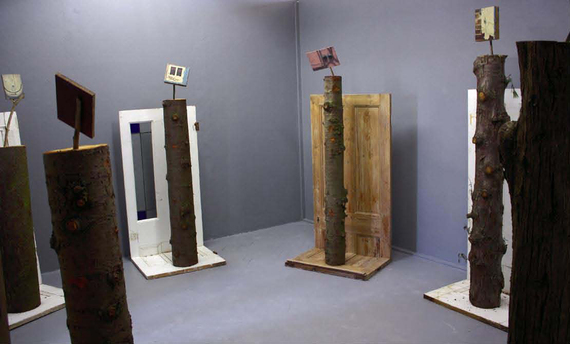
Fiona Long, Forest Fresh (2010), installation with reclaimed doors, natural timber, and oil on board paintings, 197" X 157.5" X 118" (courtesy of the artist)
"I have been acutely aware of recycling all of my life because my father ran his own consultancy business in waste management. But the process of incorporating discarded materials into my art really began when I moved back to London after a period of living in the country. My initial reaction was a very black and white opinion that the country was beautiful and the city ugly. I soon realized that some of the most overlooked aspects of the city can be the most sublime. I think that this happens most when nature begins to encroach on the man-made. This wabi-sabi aesthetic moves me and I aim to help others tune into these poignant phenomena. I stepped up the interest in 2008 having spent time on Orford Ness with artist Matthew Roberts. It's an extraordinary place scattered with derelict military testing buildings and ordnance. It is like a desert wilderness where nature is wreaking its own havoc now. There is a metal lamp with significant stalactites for example quite apart from all the rusty objects. Spending two weeks there and being privileged to stay on the spit meant experiencing the true emptiness of the place and it had a profound affect on my work. The nuclear testing made me conjure up a post apocalyptic vision, which dominated my work for years. It was not so much about the apocalypse itself but more about what the archaeology of the future might tell us about our civilization today."
"I want the viewer to regard the mixture of contemporary but old looking objects, combined with bush-craft techniques to make them puzzle about how this could have come to be. The aim was to play with anachronisms and create rather a romantic future nostalgia for a simpler time following our mass consumer culture now. The drawback was that people needed the word apocalypse to see what I was getting at, and the moment they heard that word, it coloured the way they saw the work. It was intended to be rather hopeful. The aesthetics of these works embraced wabi-sabi to show the beauty of transience and imperfection. I explore human ingenuity by assembling sometimes practical objects using contemporary fragments with bush-craft materials. Practical ingenuity seems to be something we are losing as we become adapted to urban living in an environment where cheap disposable plastics are easy to come by."
"I prefer my views to be subtle. I find that ecological art can become preachy and can become more of a political device if not carefully handled. Not to say that something can't be both art and politics but I believe that more subtle art has a better effect as people don't like to be told what to think. It's much better to make up one's own mind having absorbed information and messages but not having them thrust upon you. I want people to be more in touch with their physical environment and the materials available within it whilst placing this knowledge both in the past and the future."
Nancy Gewölb Mayanz has her studio in Valparaíso, Chile. She is a visual artist, as well as a poet and performance artists and it shows in her art, which has an ethereal or transcendent quality all its own.
Ms. Mayanz responses: "I use discarded leather that I find in upholsterers shops that came off of old sofas and chairs, and I turn them into sculptures and tapestries"
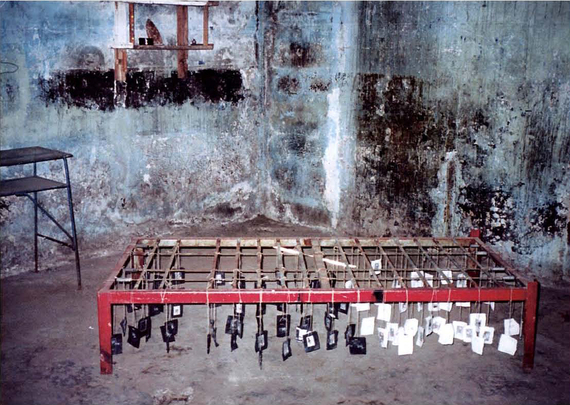
Nancy Gewölb Mayanz, Un Dia (One Day) (2001), photographs, knotted leather, string, ritual objects and bedframe in abandoned jail cell, 75" X 35.5" X 12" (courtesy of the artist)
"Sometimes I Feel I am like a bird looking for materials to make its nest. Once, I was in a shop looking how this man striped off a sofa covered with old, frail, dry, stained and scraped leather, and suddenly, I saw the memories imprinted in it: memories of bodies, human grease, spots of spilled meals, blood, sperm, tears, and above it, the animal that gave its life in exchange for being shown sprawled as a place to sit.
"I do not think that any message I would send to the viewers is received as I want it to be received, but I do not loose hope. I want them to enjoy the way I show my inner world, and through it I would like them to see with awe, the hidden questions and meaning of those works of art that I made out of that old and raw material, the memories imprinted in it, and the sadness of this planet that is also giving its life in exchange for being sprawled at our feet as another kind of trophy."
"I am a socialist to my core, I do not belong to any political party, I believe, as Ivo Andric says, that " life is a long illness that begins at birth and ends with death." I am not afraid to love my family, that I must have my solitude, that I need and love and hate the works of arts I am making, but I can not live without creating them, so I am at ease."
Alex Mazzitelli has his studio in Leicester, England. His art is as much performance as it is static sculpture. There is a certain element of viewer's mental or physical interaction that either completes or drives the work. He, with his art is a strange reflection of us, and it may bring us pause, surprise us with whit, or shame us into caring.
Mr. Mazzitelli's responses: "Almost every part of my work is found in the streets, junk shops, charity shops, markets and also secondhand shops - it is very rare for me to use new objects. I begin by combining the objects I gather them together until I get a combination I like. Then, I add paint or a material like plaster or latex to manipulate an object to get the desired effect."
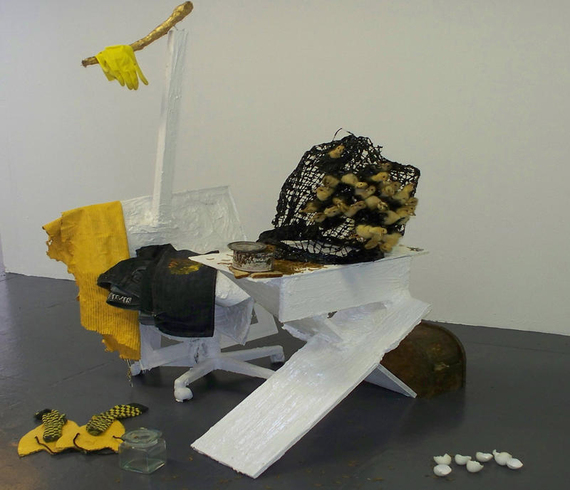
Alex Mazzitelli, Ducks - Making Sence of Nonsence (2010), mixed media, 67" X 59" X 63" (courtesy of the artist)
"Well, I believe that any object or thing can be brought together to make art, and I believe found objects are there for anyone to stumble upon to be used for art. The found objects can also inspire or make us think. I believe things happen for a reason, and this is true with objects as well. If I see something, and I like the look of it or think it may come in handy I take it. Occasionally, it can be the very thing I have been searching for to complete a piece of work, or sometimes I will keep an object until it becomes useful to another piece or work."
"I hope that people realize that junk can be made into something interesting, that it can be something that makes people think differently. I believe that we, as humans, waste too much, and we should try to think more about the way we discard unwanted rubbish. I believe recycling is a big thing that we must address. Every object can be used for another use. An unwanted tube can be used to mix paint, hold pens, or even flowers."
Yehudit Mizrahi creates sculptures, which also include sound and kinetics that celebrate the strengths and frailties of life. Her assemblages are curious combinations that blend vintage objects with an occasional eye to the future. This makes her sense of time her most compelling feature. Ms. Mizrahi's studio is in Amsterdam, Netherlands.
Ms. Mizrahi's responses: "Metal, water pipes, furniture, cloth, televisions, wood, basically everything which fits the concept of my art work."
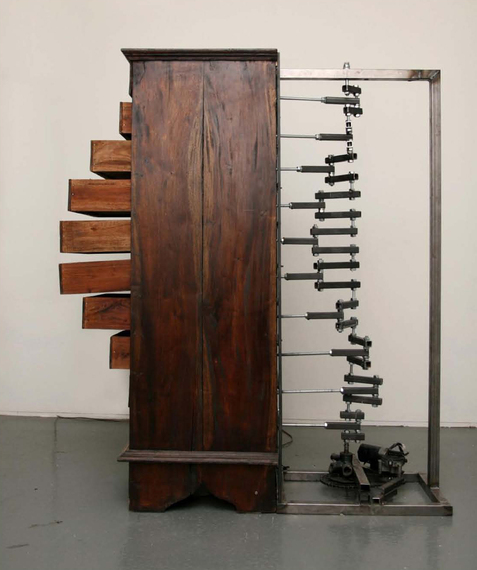
Yehudit Mizrahi, CRANKY TONE GENERATOR (2008), closet, wood, metal and electronics (Kinetic Sculpture), 53" X 37.5" X 16.5" (courtesy of the artist)
"Each section of Amsterdam has its own garbage days spread along the week. It is a 'second hand shopping mall' where you can find things you never thought you will ever dare to buy. Since I am making kinetic art, I find most of my motors in car junkyards. I remember the first time I entered a Metal junkyard in Amsterdam's east. The workers there were fully surprised to see me climbing in to a huge container filled with mountains of goods. The celebration of the Dutch Queen's birthday (well it is actually her mother's birthday) allows everyone to sell whatever they want and this is a great opportunity to acquire unique objects."
"My interest in working with discarded objects started with an idea; I wanted to create an orchestra out of furniture. All along my search, I understood that I am searching for objects that I could feel a history or story behind it, and that I can mechanically manipulate it to be an instrument. Since I made this series of work called "If Grandma Had Wheels..." I was hooked.
"I never thought in terms of a message, at least not before I read your question. I do believe in recycling, I find a lot of beauty in old material. 'Old' things have scars, have wrinkles, have the dust of dreams and smells emitting from them. Such things have stories and, like time capsules, take us places. To reuse old objects and to bring it back to life is not a new idea. Back in the old days, things were made to last and when objects finished its roll it became something else. In those days, due to poverty, people had to be more creative. As for the viewers, I surely hope that they understand the importance of recycling, though I don't actively send this message via my art. It just happens"
"It feels like the world is out of balance due to my aversion towards mess production and its aftereffect disease: Consumerism."
Mona Naess has her studio in Oslo, Norway. Her art references both the physical and spiritual words. There is a reverence in her installations, like alter pieces or monuments, as Ms. Naess elevates the overlooked to the level of the divine.
Ms. Naess' responses: "I collect and recycle mostly what nature has discarded or what has been in contact with Earth over time. I often use materials that I find on the beach where I live; water-polished bones, dead fish and birds, driftwood, terra cotta fragments, smooth porcelain pieces, rope-tangles, corrugated iron objects and old rusty farm tools. I also collect dead animals, birds and horns that I find in the woods and human hair from friends. In addition to the "discarded nature", I use Pure Nature - clay and porcelain, naked - rarely glazed."
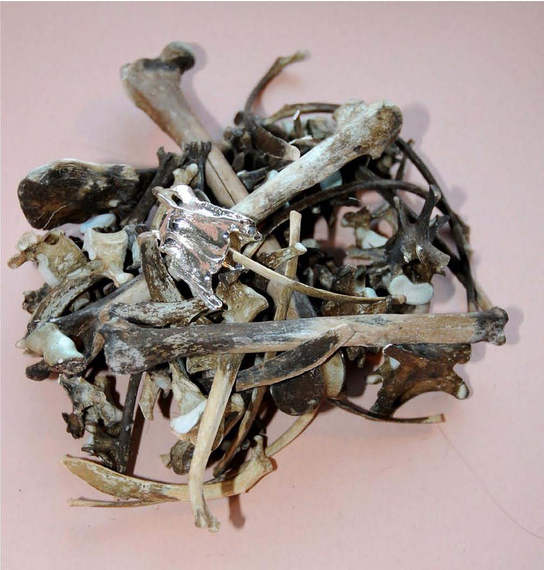
Mona Naess, Only the Muddy Fox Lives (2008), skeleton and silver, 169 fragments, 2" X 8" X 8" (courtesy of the artist)
"I've spent half my life helping commercial operators sell their goods as quickly as possible. After many years as a professional designer in the advertising industry, I decided I would no longer contribute to the disbursement of "new" objects. I wanted to use art as a tool to communicate an important ecological message."
"The aesthetics of nature is superior, but I am rearranging and staging an "awful & beautiful mix," and I hope that the viewer will recognize nature in an uncomfortable distorted way that would initiate a process of thinking beyond the simple art-object. I try to arrange an earth-dialogue; to present and twist the obvious."
"I am concerned about our interference with nature. My projects are grounded on a quest to explore the effects of the extinction of thousands of species each year."
Kalle Juhani Nieminen is visual artist from Helsinki, Finland. There is fun and frailty in his work, but there always remains optimism. His art is a celebration of life, and how life must hold both the flowers and the thorns.
Mr. Nieminen's responses: "I have used several recycled materials in my art work. Lately, I have been collecting cigarette ash from public ashtrays. Other recycled or discarded materials I have been using in my art are cardboard, beer bottles and cans, cast iron, different wood-based materials, six-pack-shells and several small objects. I found my materials from random places, sources and in different situations. I try keep my eyes open all the time.
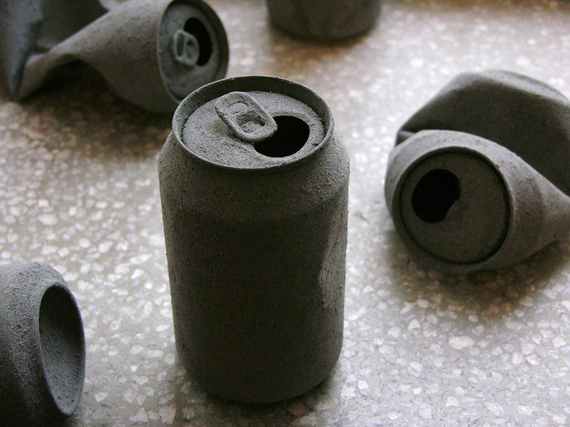
Kalle Juhani Nieminen, B-Day (detail) (2010), site specific installation of ash-covered beer placed in sauna´s change room, size variable (courtesy of the artist)
"The starting point of artistic use and collecting these materials was my general interest for extremely cheap materials, combined with the possibility of making art and expressing poor economic conditions. Currently, I am working with cigarette ash and beer cans, as it relates to material and conceptual addictions in contemporary western society. Overall, my main subject is border-crossing and definitions between pleasure and slaving addiction."
"Esthetic and ecological qualities can be combined with imagination, thinking and intense attitude. Trash is just a word. Art is the widest way to approach and to be human. It is a void waiting to be filled with different transforming perspectives."
Frank Plant, who currently works out of a studio in Barcelona, Spain, makes sculptures that turn the familiar into a type of subtle propaganda. Mr. Plant mixes his metaphors in strategic, and at times, humorous ways creating works which are both familiar and foreign.
Mr. Plant's responses: "I use anything and everything from everywhere to make my art. Lately, bones and crushed, flat rusty, old tin cans have been my materials of choice. The bones I get from the butcher, and the cans I found walking next to the train tracks near Elche, Spain."
"Every material or object has inherent qualities that are expressive by nature. With found and recycled objects, I am often dealing with the weight of their previous incarnation. In a manner of speaking, I hijack the objects to suit my needs, integrating them into my own previously established vocabulary. Found objects serve as a prepackaged bundle of values and aesthetic information."
"Most recently, I work with Flock (small fiber particles), especially the kind that model railroaders use to create mini landscapes. This allows me to mimic organic material to broach a variety of issues - some social and some political. These range from observations on the construction boom in Spain, to reflecting on individual's and asking if they were a garden, what type of garden would they be? A wild forest or Versailles?"
"My work is more political/social than philosophical, although one could see them as intertwined. I like to observe social and political dynamics. Sometimes my pieces are just that: observations on said dynamics. At other times, they are commentaries on those dynamics. I like to focus on balance and imbalance, harmony and discordance to discern the "composition" or tonal qualities, cut not necessarily in a formal sense of a situation. I think it's very important for creative minds to reflect on social and political issues."
Lina Puerta's art is steeped in natural forms, She creates fantastical scenes where color and texture are pushed to the limit, and life blooms and bubbles from the surface. But it is not all perfect - there is that tinge of danger - of not knowing if something in the mix has a poisonous offering for humans who get to close. Ms. Puerta, who was raised in Columbia, South America, has her studio in New York City, U.S.A.
Ms. Puerta's responses: "I use Styrofoam and wood, for building the structural form of a piece, to small plastic caps and ordinary found objects, such as in suitcases. If I have a specific material in mind, such as artificial plants, I try to buy from places that sell recyclables, for example, Film Biz, Build it Green, thrift stores and if I am creating a work for a non-profit exhibition space I may find materials from material for the arts."
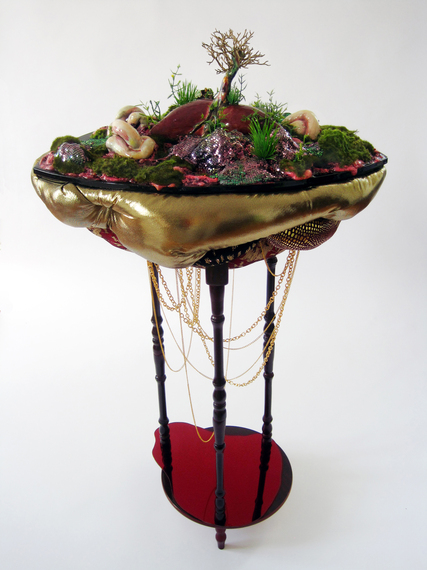
Lina Puerta, Highness (2011), polyurethane foam, wood, resin, clay, paint, fabric, fiberfill, model trees, rhinestones, trims, notions, beads, chain, hardware, cotton thread, acrylic sheet, artificial plants, moss and found object, 40" X 22" x 15.5" (courtesy of the artist)
"I don't recall a specific incident but I think as an artist working three-dimensionally, you are quite aware of everything that is form into space, and therefore discarded objects become so attractive or hard to go unnoticed. Personally, I have been interested in working with different materials and textures, and very often discarded materials naturally acquire interesting forms or surfaces, as they have been modified by time and wearing."
"We are one with nature, and what we do to it we do to ourselves."
Kevin William Reed has a skateboard, tattoo, streetwise esthetic that powers his work. He turns found and decrepit pieces of wood into wildly brutal and beautiful narratives that are a big part of his life-long esthetics and beliefs.
Mr. Reed has his studio in Brooklyn, U.S.A.
Mr. Reed's responses: "I recycle such things as wood, scrap metal or scrap fabric, cast iron spikes and windows in my work. I find these things throughout the industrial sector of Brooklyn that surrounds the Navy Yard, which includes a 30 to 40 block walk from the warehouse building that houses my studio, the industrial loading docks, corporate dumpsters and general piles of trash. These become the basis for my paintings of "Dead Things": half creature, half skeleton mash-ups."
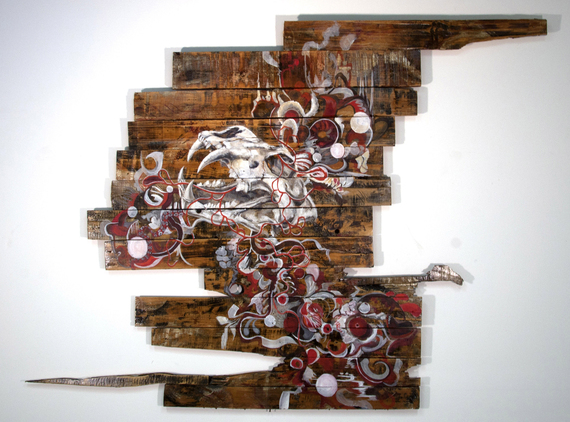
Kevin William Reed, Roaring Screamer (2011), acrylic on found wood, 62" X 79", (courtesy of the artist)
"Ever since I was a child, I have had a fascination with dead things as craft materials. I find there is an inherent beauty in the nastiest and dirtiest of the discarded wood and palettes. The scavenging, the pulling apart, reconfiguring and reattaching the elements reminds me of the same quality of craft that my Grandmother and I would do every summer on her farm with found carcasses."
"I hope the viewer sees my work and finds a different perspective on what is beautiful. In terms of ecology, my intent is not to spread a green message or insight ecological care within my work. However, while this is not an initial goal of my work, I feel it does quietly emphasize ecological issues whereby the viewer may reconsider the "trash" that they and their neighbors have as being something else, something useful."
"In the past 75 years death has increasingly become more taboo, more avoidable and more removed from society in the U.S. and I think this is creating a less diligent, more fragile group of humans. The found objects in my work serve as a platform to communicate to the viewer that dead, discarded and derelict things are beautiful, and that there is nothing to fear."
Quim Rifà has his studio in Barcelona, Spain. His art bridges the gap between humor and the absurd, intriguing us with new and creative ways of viewing our everyday world. He can bring animation to an inanimate object, elevating the banal. Whatever Mr. Rifà makes, his art has the main purpose of activating the freethinking, wide-eyed child in all of us.
Mr. Rifà's responses: "The materials that I use there are several, such as old sewing machines or typewriters or tools of the kitchen. I like these materials because they already have charm.. Normally, my friends and family tell me in advance when they about to throw something away, and if the material is interesting I will pick it up and bring it to my studio for future use."
"My relationship used materials as an art medium started when I was living in Berlin. There, I had the first contact with artists who used recycled materials as primary material for their work. I was impressed by this potential because I was without a workshop or primary material to work with. These artists opened me to a new world."
"My hope is that the esthetics of my sculptures will inspire the public to think beyond the original purpose of objects and find new and creative uses for them so they don't end up in the streets or as garbage."
"Artists use their language to reflect the society and what happens in it; and it is at this moment that the world has a major environmental problem with the waste that humans create. I would like to help make the change toward a better world."
David A. Smith has his studio in Peterborough, England. His art is austere, focused and foreboding. His subjects are haunting, while the surfaces he creates are refined, and crisp. Smith repurposes natural materials, bones, teeth, minerals and a variety of earth borne materials in his art. This brings a spiritual presence to his figures, as well as life and death to his art.
Mr. Smith's responses: "I use a lot of natural materials and these are quite easy to find if you know where to look. In the past I have used discarded Deer antlers or animal bones from various sources. I would say I am as much of a salvager as I am a recycler."
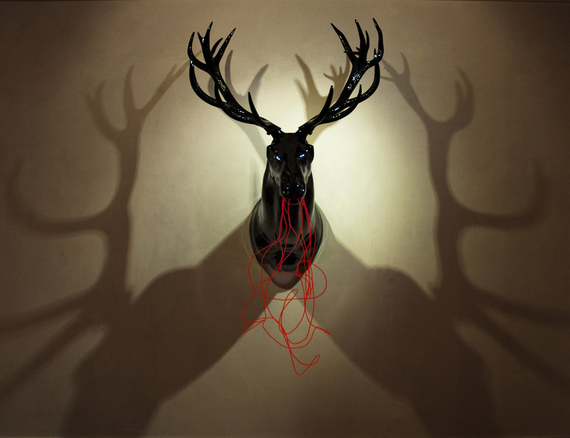
David A. Smith, Glory (2010), rigid foam form, eL wire, red deer antlers, gloss black finish, 35.5" x 43" X 27.5" (courtesy of the artist)
"I have always been drawn to nature in one form or another. As such the surviving elements that are strongest after the demise of a creature are its teeth or skeleton, or antlers in the case of Deer that shed them. I would say for me those structures that life build on, cling to physically, are very special as they are present at the end of things. These lingering components of the body that survive decay are fascinating and deserve some sort of investigation and celebration."
"Aesthetically, I aim to entice the viewer with the natural form entwined with technology or adorned by luxurious finishes. I would say that given much of my work centers on the elements found from death, or the celebration of reclaiming natural forms, that in an ecological sense I want to show nature as the untainted lead. From beginning of life to the end it is based on instinct and sometimes ritual. I know that natural forms may be an obvious way to do this but it's always about applying light touches and careful consideration before any idea is realized."
"I only strive to produce what I am passionate about. If in turn that creates a social or political discourse then that can't be a negative outcome. However for nature to survive, and for us to survive, a balance and understanding is still needed. I don't think we are as harmonious with the environment as we could be."
Isa Tenhaeff has her studio in Amsterdam, Netherlands. Her art plays the physical world against the psychological. Her compositions and installations conjure up all sorts of emotions and feelings that can be anywhere from political to playful, or mysterious to menacing. There is a frailty to her art as well, a vulnerability that is quite compelling, and at times, puzzling.
Ms. Tenhaeff's responses: "For my art I collect used objects ranging from broken toys, precious clothing and building ornaments from the trash to fine art prints and my own academy drawings and paintings. I look for "gem-quality" in the materials I collect: these things are often broken or worn-out but there is a spark - a classic sense of power or beauty that I can use. Also my objects have to bring up a lot of different (personal, public, historical references, etc.)."
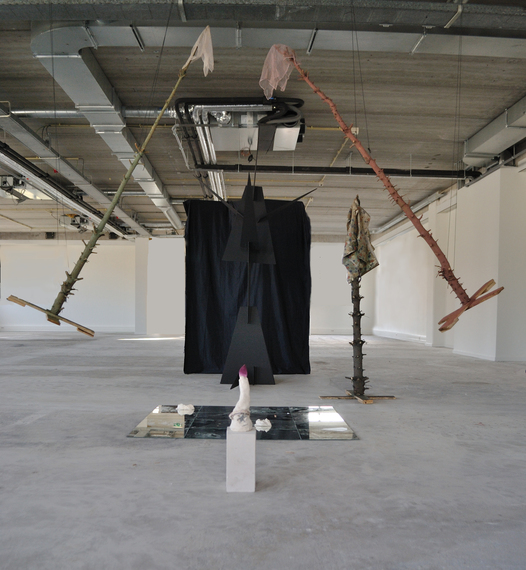
Isa Tenhaeff, Trees in a Forrest (2011), mixed media installation, 138" X 138" X 275.5" (courtesy of the artist)
"I work from historical images and from a notion of historical continuum in which patterns, compositions, notions of proportion, etc. are repeated. As a sociologist I am trained at looking at people, and of seeing patterns in behavior and in the material outcomes of this behavior. In rough lines images and structures are repeated over and over, though details may vary. I look for these kind of patterns in 'old' art and architecture and find absurd similarities to our world today. Similar to the idea of golden ratio, I search for the best ways to bring out these immaterial references through ordering materials."
"History, meaning and beauty are not about power, status and priceless materials, but about ordering or arranging architecturally); finding the right 'engine' for an installation and seeing."
From Christchurch, New Zealand, and the surrounding countryside, Matthew George Richard Ward creates highly conceptual, ephemeral works that are as challenging as they are distinctive. He constantly pushes his art in any number of directions, incorporating many levels of conscious thinking and theory from the banal to the sublime.
Mr. Ward's responses: "I often recycle found materials that commonly coincide with my movements. Currently, I am nomadic, and my movements influence the work I produce. Materials can vary from internet sources to collections of personal documents, found to gifted to borrowed objects, or purchases from opportunity shops, free bins, or things I happen to find in alleyways, or in a pile of boxes waiting to be picked up, things I find in a public toilet, a government office - it really depends on when and where I am or who I am with - and often whether or not I have a camera. I am active online, notably on Facebook (utilizing a kind of subjective displacement) for storing and sharing images."

Matthew George Richard Ward, Wash it Down with Cola and it's the Temne Language of Sierra Leone (installation view) (2011), mixed media, size variable (courtesy of the artist)
"The relationship between usefulness and uselessness has always interested me since my discovery of Eastern religion(s) and philosophy. As humans, we consume in excess; I am drawn to the phenomenology that exists between subject and object, or the confusion in the affectation of language in time and space and how it affects our thinking and feeling of being and or not being. Being here, being there, what is a human life? I want to embrace this experience and examine difference and the dichotomy between the self and other through subject to object relationships. My work also deals with the pornography of information and communication. My fascination toward discarded materials is perhaps linked to my interest in sound collage and sampled music in my adolescence."
"I am open to new ways of seeing, through the realities and connections between our inner and external worlds. I am influenced by change, sometimes the line between beauty and hideousness, for what is beauty in the mind of the viewer? As media covertly saturates our minds, we become more and more effected by it in subliminal ways. This saturation is inspiring to me, and it helps me discover and constantly redefine what it means to be a human being and a contemporary artist. I am investigating ideas of authorship and authenticity; I believe that the conceptual, pragmatic and emotive are inextricably linked. What is necessity, what is superfluous? These are questions I hope that the viewers of my work may consolidate."
"I believe all art is political in one way or another. I am interested philosophy, some examples can include Anarchism, Neo-Marxism, Daoism, Ch'an and Zen Buddhism, Post-Structuralism and Feminism."


